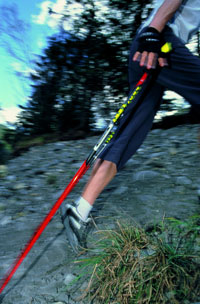The technique of Nordic Walking and Hill Walking
A typical training session from Leki on Nordic Walking in the UK
In order to get a more 'hands on' introduction to Nordic Walking, Leki were kind enough to provide us with one of their training consultants for a couple of hours. And Theresa Howard from the go4awalk.com office volunteered to be put through her paces . . .
Here's her report.
 Photo by M Zimmermann
Photo by M Zimmermann
The Nordic Walking training session started with a quick look at the poles: their basic design (light, slimmer than a trekking pole, very flexible) the strap that attaches pole to hand and the height adjustment.
Now on to my stance. "Keep relaxed and face forward" was the quite reasonable instruction on this.
Next came an intro to the 'active footwork' that is one of the basic movements in Nordic Walking. This means that you roll off the foot from the heel through to the toe - this has the effect of really working your calf muscles.
Now back to the poles and to what I suspected was going to be the part of the session that would be the most intriguing. I do walk anyway with trekking poles - albeit usually with one – so I was very interested to see exactly what was the difference when using poles the 'Nordic Walking way'.
The first challenge was to master the grasp-release-grasp sequence. This is where the subtle differences in the top end of the pole become important. There's a strap that keeps the pole in position as you open your hand and release your hold. The pole also extends slightly above the top of your hand allowing you to roll your hand along the pole as you release it and push back.
The placing of the pole is also different. A trekking pole is placed slightly in front of you. However a Nordic Walking pole is placed to the side and then you actually walk past it - so the pole really does spend a lot of time behind you. This sequence of movements with the pole - when done properly - provide the workout of the muscle groups around your arm, shoulder and upper back.
And I did begin to experience that even though some of my pole movements were somewhat ragged! Clearly this is one of the areas one needs to practise!
Now came the opportunity to try and put all this together. I started walking, holding the poles but with the arms hanging at my side. By starting to swing my arms slowly, then more actively - I did quickly find that I could walk with arms, legs and poles reasonably well co-ordinated. In fact this did feel quite 'natural'. It was only when I started to actually think about what I was doing that I started performing the infamous 'Spotty Dog' impersonation. (For those not familiar with this 'style', it's when your right arm/leg move together then your left arm/leg move in the same way. This is apparently a common lapse amongst Nordic Walking debutantes.)
We next looked at the Nordic Walking technique for dealing with hills. We were in a suburban park for this session so the hills available were relatively gentle. The Nordic Walking method of going uphill uses the same approach as I would use anyway when hill-walking - ie lean forward and use the poles to help propel you upward. Of course, there was a definite benefit from having two poles rather than my customary one. Descent, however, is a little different. You bend your knees (so lowering your centre of gravity) and keep the poles behind you (where they can offer support if your feet slide forwards). Feeling more stable than is often the case, I was more able to control the speed of my descent.
After a few more practise ascents and descents we ended what had proved to be a very enjoyable couple of hours.
So, what did I think? For me, Nordic Walking does have much to offer. I liked the co-ordinated movements and the way in which you can workout your upper body to a greater extent than when walking more conventionally. As someone who enjoys being outside, this seems to be a far more enjoyable way to 'work-out' than sweating in a gym. The main investment is in the poles and in suitable footwear. However, there's no reason why Nordic Walking poles can't be used as trekking poles and you can use - as I did - low level walking boots on your feet.
I guess a drawback for some may be the rather stylised movements - particularly in the early stages. Emulating The Wooden Tops' Spotty Dog - the 1960s children's TV character (and the spottiest dog you ever did see) - may be a bit much for the self-conscious in some situations.
Once I've acquired some poles, I'm looking forward to practising on some of our lower-level walks . . . perhaps when I'm striding past them, I'll convert some of my currently sceptical walking companions!




















